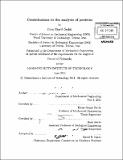| dc.contributor.advisor | Klaus-Jürgen Bathe and Mark Bathe. | en_US |
| dc.contributor.author | Sharifi Sedeh, Reza | en_US |
| dc.contributor.other | Massachusetts Institute of Technology. Dept. of Mechanical Engineering. | en_US |
| dc.date.accessioned | 2011-12-09T21:30:16Z | |
| dc.date.available | 2011-12-09T21:30:16Z | |
| dc.date.copyright | 2011 | en_US |
| dc.date.issued | 2011 | en_US |
| dc.identifier.uri | http://hdl.handle.net/1721.1/67599 | |
| dc.description | Thesis (Ph. D.)--Massachusetts Institute of Technology, Dept. of Mechanical Engineering, 2011. | en_US |
| dc.description | Cataloged from PDF version of thesis. | en_US |
| dc.description | Includes bibliographical references (p. 131-145). | en_US |
| dc.description.abstract | Proteins are essential to organisms and play a central role in almost every biological process. The analysis of the conformational dynamics and mechanics of proteins using numerical methods, such as normal mode analysis (NMA), provides insight into their functional mechanisms. However, despite the fact that much effort has been focused on improving NMA over the last few decades, the analysis of large-scale protein motions is still infeasible due to computational limitations. In this work, first, we identify the usefulness and effectiveness of the subspace iteration (SSI) procedure, otherwise widely used in structural engineering, for the analysis of proteins. We also develop a novel technique for the selection of iteration vectors in protein NMA, which significantly increases the effectiveness of the method. The SSI procedure also lends itself naturally to efficient NMA of multiple neighboring macromolecular conformations, as demonstrated in a conformational change pathway analysis of adenylate kinase. Next, we present a new algorithm to account for the effects of solvent-damping on slow protein conformational dynamics. The algorithm proves to be an effective approach to calculating the diffusion coefficients of proteins with various molecular weights, as well as their Langevin modes and corresponding relaxation times, as demonstrated for the small molecule crambin. Finally, the structure of Homo sapiens fascin-1, an actin-binding protein that is present predominantly in filopodia, is examined and described in detail. Application of a sequence conservation analysis to the protein indicates highly conserved surface patches near the putative actin-binding domains of fascin. A novel conformational dynamics analysis suggests that these domains are coupled via an allosteric mechanism that may have important functional implications for F-actin bundling by fascin. | en_US |
| dc.description.statementofresponsibility | by Reza Sharifi Sedeh. | en_US |
| dc.format.extent | 145 p. | en_US |
| dc.language.iso | eng | en_US |
| dc.publisher | Massachusetts Institute of Technology | en_US |
| dc.rights | M.I.T. theses are protected by
copyright. They may be viewed from this source for any purpose, but
reproduction or distribution in any format is prohibited without written
permission. See provided URL for inquiries about permission. | en_US |
| dc.rights.uri | http://dspace.mit.edu/handle/1721.1/7582 | en_US |
| dc.subject | Mechanical Engineering. | en_US |
| dc.title | Contributions to the analysis of proteins | en_US |
| dc.type | Thesis | en_US |
| dc.description.degree | Ph.D. | en_US |
| dc.contributor.department | Massachusetts Institute of Technology. Department of Mechanical Engineering | |
| dc.identifier.oclc | 764449130 | en_US |
